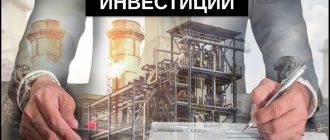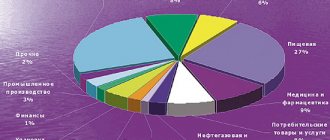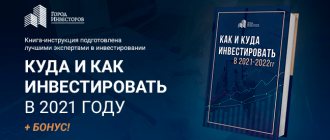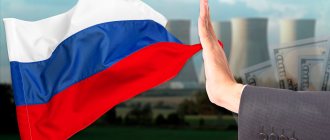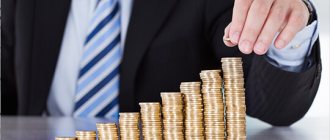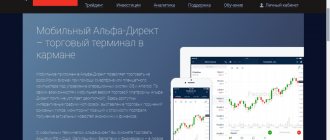Investments in fixed capital are beneficial for both parties entering into a transaction. They are necessary to start a business and subsequently make a profit, which is both the goal of the entrepreneur and the goal of the investor. How to attract investment in fixed assets and what this concept includes will be discussed in this article.
What is investment in fixed capital
Investments in fixed capital are understood (section II of Rosstat order No. 746 dated November 25, 2016):
- costs of creation, reconstruction (modernization) of facilities, purchase of machinery, equipment, inventory, classified from an accounting point of view as non-current assets;
- investments in intellectual property;
- investments in biological resources.
Investments in fixed capital can be made both at the expense of one’s own funds and at the expense of borrowed (or received as assistance) funds, within the framework of exchange agreements and equity participation agreements.
Investments in fixed capital do not include the cost of acquiring assets whose price is less than 40,000 rubles, except for cases when these assets are reflected in accounting as fixed assets.
The following are not recognized as investments in the fixed capital of an organization:
- purchase of fixed assets that were previously on the balance sheet of third-party organizations;
- costs of purchasing apartments in multi-apartment residential buildings;
- purchase of land plots, environmental management facilities;
- concluding lease agreements, purchasing licenses, purchasing goodwill, marketing connections (related to non-produced assets in accordance with the system of national accounts).
A synonym for the concept of “investment in fixed capital” is “capital investments” (Article 1 of the Law “On Investment Activities” dated February 25, 1999 No. 39-FZ).
It should be noted that investments in fixed assets (as opposed to, in fact, fixed capital) are outside the jurisdiction of the main sources of law governing the accounting of fixed assets - Order of the Ministry of Finance dated October 13, 2003 No. 91n, as well as PBU 6/01. What rules of law should be considered as guiding principles when accounting for capital investments?
What is this
Investments in fixed capital are total expenses that are designed to expand or update fixed assets, carry out certain construction work, or do any other actions that will increase the initial price of the product produced.
The amount of invested funds can accelerate the level and rate of growth of a particular enterprise, the global situation in the industry and strengthen the country’s economy as a whole. But only on condition that such investments are carried out en masse and in all areas.
Today, considering processes globally, IVOK has the following structural features:
- Funds allocated for modernization. This includes the purchase of inventory, equipment, instruments, machines and other things. These are the so-called non-current assets.
- Investing finances in biological resources. That is, investments are made in human capital.
- Investing in intellectual property.
Based on the form of finance involved, the following are distinguished:
- Own material contributions.
- Credit money.
- Money from barter or equity participation.
Accounting for investments in fixed assets: basic regulatory standards
The legislator's main attention is paid to accounting for the results of investments - directly the fixed capital listed on the organization's balance sheet. As soon as fixed capital is formed and reflected in accounting at its original cost, it already falls under the jurisdiction of the specified rules of law - order No. 91n and PBU 6/01.
Until the moment an object of fixed assets is registered, an accountant can legally be guided by only one source of law - Order of the Ministry of Finance of the Russian Federation dated October 31, 2000 No. 94n, which introduces charts of accounts used by private enterprises.
The essence of investment
The main task of any enterprise is to make a profit.
In addition to a powerful marketing strategy, this requires a high-quality final product that will conquer a permanent market. To get ahead of competitors and stay on top, the work of an enterprise requires constant updates:
- installation of modern equipment, which often leads to speeding up the production process and reducing costs;
- introduction of new technologies to improve product quality;
- launch of a new production line to expand the range.
In addition, in the process of work, equipment, machines, premises, machines and other objects that are part of the organization’s fixed assets wear out. All this requires investing money in restoring and updating work tools.
Investments in fixed assets are represented by:
- Construction of new buildings, current and major repairs of existing premises;
- Purchase and installation of new equipment;
- Updating tools and household equipment;
- Purchasing new vehicles for the company;
- Issue of securities (bonds, company shares) and their sale in order to attract additional capital for development;
- Brand development, obtaining a patent or registration of copyright.
All these actions are aimed at increasing the efficiency of the company. At the same time, this category does not include:
- purchase of fixed assets that were used by other companies;
- purchasing apartments in multi-storey residential buildings;
- purchase of land;
- expenses for obtaining a license permit, rent, advertising.
Formation of your portfolio
This format of investment involves the acquisition of various assets. The main goal of an investor is to generate income. The portfolio is formed by various assets. It may include securities, real estate, and antiques. Ownership of shares and bonds usually does not include participation in management processes, and investing in this format is considered passive.
The task of an investment portfolio is to form assets that will provide maximum profitability with reduced risks and sufficient liquidity. By properly planning the placement of money, assessing the income component in advance, adjusting the composition in a timely manner and getting rid of illiquid items, you can guarantee yourself a stable financial position in the present and future.
Source
Dynamics and growth rate
Considering the dynamics and structure of investments in fixed capital in Russia, both in the form of long-term and short-term investments, it is worth noting the following figures issued by the Federal State Statistics Service:
- In 2010, as a percentage of the previous year, this amount was 106.3%.
- In 2011 the amount was already 110.8%.
- By 2012 – 106.8%.
- 2013 was marked by stabilization at the level of 100.8%.
- 2014 showed a decline to 98.5%.
- 2015 continued to show a decline of 89.9%.
- But in 2021 the situation also remained in the negative – 99.8%.
- By 2021, the situation has changed. The growth was 104.8%.
- 2018 showed almost the same figures as the previous reporting period - an increase of 104.3%.
But overall figures do not reflect the full picture of investment in the Russian Federation. This indicator must not only be considered for the country as a whole, but it is also important to analyze it for the constituent entities of the Russian Federation.
Capital investments depending on the region, taking into account the time factor, are as follows:
- In the Central Federal District, an increase in invested material resources was observed from 2005 to 2008, from 2010 to 2012. But, starting from 2013, there has been a regular decrease in this coefficient, with the exception of a slight increase in 2021 and 2018.
- In the Northwestern Federal District there was an increase from 2000 to 2008, 2010 to 2012. Between these periods, low activity was observed. But in the last two years the situation has improved slightly, although the amount of invested funds is no longer as large as in prosperous periods.
- The Southern Federal District showed a decline in 2009, like previous regions, and then from 2014 to 2021. 2021 also turned out to be a failure. In other periods there was systematic growth.
- In the North Caucasus Federal District, growth was from 2000 to 2005, in the period from 2007 to 2014. But 2009, and then the period from 2015 to 2021 were negative for the development of industry as a whole.
- The Volga Federal District also maintains general statistics. 2009, and then the period from 2014 to the present, is a stagnant period for the development of industry and other areas and enterprises.
- The same situation is developing in the Ural Federal District with one small difference: in 2021, 2021 and 2021, there is minimal growth in terms of investments and their efficiency ratio.
- The Siberian Federal District also showed a decline in 2009, although before that there had been systematic growth since 2000. Then, starting in 2013, investments again tended to minus. And only starting from 2017 there was a slight increase.
- The Far Eastern Federal District (FEFD) in 2000 showed a negative coefficient in relation to the previous reporting period. Then, starting from 2005, there was a systematic increase until 2011. And starting in 2012, there was a decline that lasted until 2021. 2017-2018 showed a positive increase.
Structure
Another important parameter is the structure of investment activity. IVOC include:
- Accounting for types of financial assets.
- Type of economic activity.
- Taking into account funding sources.
- Accounting for economic activity.
By type of fixed assets
If we consider the percentage distribution of PF, statistical data on average from 2000 to 2021 fluctuates around the given figures:
- In housing – about 13% on average.
- In buildings and various structures with the exception of residential – 42%.
- In cars, vehicles, instruments and other equipment, about 37%.
- Intellectual property objects - 3.5%.
- Other types – 6%.
If we take into account this expression in rubles, then statistics provide the following parameters for 2021:
- The amount contributed to housing was RUB 2,321.9 billion.
- In non-residential structures and buildings - 7542.8 billion rubles.
- In machinery, equipment, instruments and various types of equipment - 6283.4 billion rubles.
- Investments in intellectual property objects amounted to 558.5 billion rubles.
- To other funds – RUB 1,075.4 billion.
By type of economic activity
The most successful, from the point of view of investing financial resources, are:
- Mining - there has been an increase since 2009 from 13.2% to 19.4%.
- Sufficient amounts are also invested in manufacturing industries, fluctuating around 14.5%.
- Agriculture shows lower figures – about 3.5%.
- Construction also has lows of around 0.7%.
By funding source
According to sources, the indicators are as follows:
- About 45% is invested from own funds. Moreover, about 20% comes from profit, 20% from depreciation and the remaining 5% from reserves.
- Of those attracted, 55% are spent. Of this amount, budget funds make up about 20%.
- Bank loans 9%.
- Bonded non-financial amounts are about 10%.
- Shares – 0.3%.
- Funds' funds - 0.5% and others - about 9%.
- Borrowed funds from other organizations are about 6%.
By type of ownership
From a property perspective, the amounts are distributed in percentage terms as follows:
- Russian ownership 85%. Of this, state property accounts for about 13%. Municipal – about 2%. Private – 61%. Mixed Russian without foreign participation about 7%.
- Foreign reaches just over 6%.
- Joint Russian and foreign over 8%.
Kinds
The type of investment depends on the purpose of the fixed capital. This:
- investments in production assets (production lines, equipment, buildings, etc.);
- non-productive investments, when cash flows are directed to the creation and development of household and socio-cultural facilities, healthcare, and infrastructure.
- Composition and structure of the IEC
The composition is well shown by accounting, in the accounts of which fixed assets are taken into account. This:
- expenses related to land plots;
- buildings, structures and communications to them;
- technological lines, machines and equipment;
- motor transport;
- furniture, appliances, tools;
- objects of intellectual property, IT development, computer software;
- perennial plantings.
According to the technological structure, investments in fixed capital are related to:
- with the execution of construction and installation works;
- with the implementation of commissioning works;
- with the purchase of equipment, tools, inventory, protective clothing;
- with other capital works.
There is another division of investments by structure (volume):
- gross – the total volume of investments from all sources;
- net - gross, reduced by the amount of depreciation.
Investment share
When considering the share of investment, it is important to consider the country's gross domestic product per capita. This marker helps to assess the development of the economy in the country as a whole. Although there are some features that are worth discussing after providing statistical parameters.
In fixed capital in GDP
So, considering the share of investment in fixed capital in relation to the state’s GDP, it is worth indicating the following percentage figures. The information is presented in table form for better understanding.
| Year of funding | Percentage |
| 2011 | 20,7% |
| 2012 | 20,9% |
| 2013 | 21,2% |
| 2014 | 20,5% |
| 2015 | 20% |
| 2016 | 21,2% |
| 2017 | 21.4% |
| 2018 | 20,6% |
Considering these indicators, it should be noted that the implementation of the May decrees did not have any effect in this area.
In fixed capital to GRP
Analyzing the volume of investments in OK in relation to the internal regional product (GRP), it is worth noting the following statistical parameters:
- Continuous growth was observed from 2003 to 2008. Over these 5 years the situation has changed from 12% to 32%.
- In 2008 and 2009 the situation remained stable.
- Starting from 2009, the indicator began to deteriorate significantly, as there was a constant decrease in this parameter.
It is interesting that despite the increasing investment in fixed assets in ruble terms, in relation to GDP it is growing insignificantly. A paradoxical situation is emerging in which investments are growing quite quickly. GDP does not show such speed parameters. But if we compare these two parameters, the amount of funds invested in investment activities decreases in relation to GDP.
This contradiction is explained by the specifics of the calculations.
Which area to choose
There are certain statistics that reflect the level of investment in fixed assets in different areas of life.
Investors are most often interested in the following areas:
- Construction of new complexes (residential, retail, office, sports);
- Cultural events;
- Agro-industrial production;
- Private provision of utilities;
- Hunting and forestry, fisheries;
- Banking sector;
- Resellers;
- Private educational institutions;
- Tourism and restaurant chains;
- Medical complexes;
- Transport and delivery;
- Real Estate>;
- Equipment repair.
Specific objects of spending funds
When making capital investments in the development of his own business, an entrepreneur, first of all, must think about what exactly he will finance, which production facilities to replace with new ones.
Investments in fixed capital include the following areas that guarantee high return on investment:
- Training of employees - obtaining skills in accounting, the art of asset management, personal growth courses, seminars on increasing their own sales;
- Increasing the number of employees and establishing additional branches;
- Conducting research – car crash tests, customer surveys, pilot projects;
- Repair of existing equipment to increase its functionality and improve quality characteristics;
- Purchasing new vehicles to increase the volume of cargo transportation or the number of passengers;
- Purchasing new tools of high quality and long service life;
- Investment in the construction of a new production building to increase sales;
- Purchase of land for the construction of additional buildings or farming.
Factors influencing return on investment
It happens that an entrepreneur has invested money, but for some reason the income from the investment does not come, or its growth rate is so low that the business owner doubts its feasibility.
When investing in fixed capital, it is necessary to take into account that this process is affected by many factors, which together can affect the result in a variety of ways.
It is important to consider the following points:
- Competitive advantages of the released product. This includes quality, originality, benefit to customers;
- Using production capacity in such a way that it can ensure the supply of the required volume of goods, but also does not stand idle;
- Promotion of services/products. Marketing policy – advertising in the media, rental of advertising banners on city streets, distribution of booklets, surveys;
- Expedient use of available funds. They need to be spent only on the most basic things and wisely select contractors and suppliers who offer low prices and high quality;
- Seek help from independent professionals who will help identify the shortcomings of the enterprise and suggest how to better manage capital.
Current statistics
As discussed above, statistical data indicate that until 2012 there was an increase in financial resources poured into various areas of production. But then the market experienced a certain stagnation in some years or even a decline.
On years
The following data is available by year:
- In 2000, the amount of financing amounted to 787.1 billion rubles.
- In 2010, the amount increased to 1,769.9 billion rubles.
- It reached its peak in 2012-2013 with figures of 2094.4 billion rubles.
- After this, a decline began, reaching 1,305 billion rubles in 2021.
By city and region
Despite the fact that there is now some crisis and recession, there are still regions that have not experienced this negative impact:
- By 2021, the Tyumen region has attracted the largest amount of funds out of all the constituent entities of the Russian Federation. Moreover, the region’s share was only 21%.
- As for Moscow, she took second place.
- After Moscow comes the Yamalo-Nenets Autonomous Okrug.
- Then Khanty-Mansiysk Autonomous Okrug.
- And St. Petersburg closes the top five.
By industry
The statistics by industry are as follows:
- The largest amount is observed in the field of transport and communications. In total, in percentage terms this area accounts for about 19%.
- Real estate is in the same niche – also about 18-19%.
- Then comes the oil and gas complex with its 14%.
- Next comes APK – about 11%.
- After this comes education, health and trade with figures of about 5%.
- About 3% of funds are invested in mechanical engineering and the energy sector.
- Almost the same amount is in the energy sector.
Where to invest
The structure of investments in fixed assets depends on the target direction for which funds are raised.
Most of the investment capital is spent on construction work (about 59%), the rest of the funds are spent on modernizing the fixed assets.
The most promising areas are considered to be:
- Investments in the construction of production facilities. They are considered as long-term investments.
- Investments in shares and other securities. The time period of investment in this case is determined by the company.
- Cash for the intangible fund. This group includes innovative developments.
- Purchase of equipment, inventory, tools.
The last point can be attributed to investing with a high probability of risk. The fact is that equipment requires large financial investments, but it takes a long time to achieve profitability. In addition, other circumstances may affect investment efficiency: equipment breakdown, decrease in consumer demand.
Attractive industries that investors are interested in include:
- Construction;
- Agro-industrial direction;
- Public utilities;
- Logistics;
- Medical centers;
- Tourist sites;
- Catering business.
Objects and income
Traditionally, own investment capital is used to expand enterprises much less often than attracted capital, since the object rarely has a sufficient amount of available funds. The classic source of money raised is corporations. About 60% of the entire investment market is formed by such saving objects. This is especially true for a developed country. Many corporations have much higher needs than savings, so the business sector is traditionally considered the ultimate borrower.
The inhabitants have some income, part of which they traditionally try to save. People are especially actively striving for this if there are incentive programs. Investing funds allows an individual to provide himself with additional income. This sector forms up to a third of all savings within the country.
Sources of financing
Investments in fixed capital are significant amounts, but without this the company simply cannot operate. There are 3 sources of funding.
Attracting investors
Third-party investors are not only interested in development, they are attracted by the opportunity to make decisions. Therefore, large third-party investments threaten the loss of independence.
Money from fixed capital investors comes as:
- income from the sale of own securities;
- profit intended for payment of dividends, but by decision of the board aimed at the development of the company;
- finances of the budgets of the Russian Federation at various levels (technical and humanitarian assistance, often provided free of charge).
Your funds
Own money is often the main source of investment in fixed assets. This:
- capital contribution;
- retained earnings;
- depreciation;
- released finances as a result of the sale of assets;
- insurance compensation paid upon the occurrence of an insured event (accident, natural disaster).
Borrowed funds
Borrowing funds for investment in fixed assets is not a good idea, since you need to pay off the added value - interest. This:
- commercial bank loans;
- loans from organizations (mutual fund, investment fund, etc.);
- federal budget loans.
Capital reallocation
Capital market investment and interest rate - these terms have appeared in our vocabulary quite recently. Along with this came the realization that money is not just a means of payment, but also a commodity. If you sell it profitably, you can earn income.
With the transition to a market economy, business entities faced the acute issue of attracting resources for further development and modernization. Bank loans could not fully satisfy capital needs. This is how the securities market appeared, which ensured the migration of capital and allowed investors to invest temporarily free funds to make a profit.
Today, the securities market is a clear, well-coordinated mechanism that has all the characteristics of a market. Its main indicator is capital investment and its types.
The following companies operate in the market:
- issuers;
- investors;
- financial intermediaries.
The capital market, investment and interest rates, as well as the entire financial market, are subject to constant control and regulation by the state. This is necessary to create optimal conditions for the development of the capital market and protect the interests of its participants. But you should not abuse administrative resources, as this may scare away investors.
Investment policy of the enterprise
For the successful development of the company in the future, the organization provides a set of measures regarding the rational use of investments, their correct combination and use.
This part of the strategic plan is called the company’s investment policy, the formation of which occurs in 3 stages:
1.Assessing the need for enterprise development
The first stage includes identifying profitable directions for the development of the company. For this:
- analysis of consumer demand for products is carried out;
- forecasting potential needs and their quantity;
- calculate how much the price of a product will change after modernizing the production process;
- identifying promising opportunities for the company;
- conduct an analysis of the enterprise’s activities over the past period and identify shortcomings.
2. Development of investment projects
Investments are being actively attracted, a strategic plan is being developed, and priority areas for investment in fixed capital are being determined.
3.Selecting a profitable project
The final approval of actions for profitable development takes place, for which you need:
- calculate the amount that will be needed for the purchase of equipment and other necessary fixed assets;
- determine the exact cost of the product after the update;
- assign the amount of future investments;
- analyze sources for investment, what part will be provided by own funds, and how much needs to be received from external investors;
- calculate the level of project efficiency and possible risks.
PKI directions
If we consider capital investments from the point of view of reproduction, then they can be divided into 2 areas:
- investments related to extensive development (expansion of existing facilities, construction of new ones);
- investments related to intensive development (modernization, reconstruction).
In Russia, over the last 5 years, construction has been in first place in terms of investment volume (57–65% of the total volume). The second is the purchase of new fixed assets (20–25%). And only then reconstruction and modernization (15–20%).
Power and what is outside it
Investment capital is created with the aim of expanding production capabilities. It can be borrowed by turning to a power, but in general the state is considered a net borrower. Authorities often raise money themselves to cover budget shortfalls.
Foreign entities can both borrow money and act as investors, as they save and increase funds. In practice, for example, Western powers always have a negative balance of investments with Eastern and Southern powers, so Western countries are considered net creditors.
How to attract an investor
Using investments in fixed capital using only your own funds is ineffective and time consuming. For these purposes, it is better to find and attract an investor who wants to promote your business and benefit from it after a certain period.
Such a person who wants to invest in the fixed capital of a company will require for consideration:
- Business plan;
- Investment agreement.
Do not expect that even if your company has been in existence for a long time, an investor will immediately invest money in your assets. Such people also think about their benefits, which they will receive during the implementation of the project. You must present your plan in such a way that the investor has no doubt about its profitability.
In this case, a competent drafting of the contract is necessary. It specifies all the rights and obligations of the parties to the transaction. If you miss some point, you may remain in debt to the investor.
It is important to include clauses that directly state that if the project turns out to be unprofitable, you will not have to pay the investor for it. The main thing is to make all the calculations correctly at the planning stage so that the investment really bears fruit.
To interest a potential investor, you need to tell in detail what benefits he will personally receive from participating in your project. If you wish, you can come up with special conditions for such a person upon completion of the project. For example, he can receive a monthly income from your profits or become a co-owner of the business.
Development of an investment plan
The planning stage for further investment of fixed capital is the most important step towards project implementation. Specialists are involved in drawing up a business plan if it is being prepared for a large company. If you have a small enterprise and you plan to raise funds from the state budget, you can write a business plan yourself.
The assessment of investments in fixed capital is carried out according to the following points, which must be indicated when planning investments:
- The purpose of the investment and its justification - what benefit will the invested assets bring;
- The amount required to implement the project in general and for each individual area. Calculation and forecasting of cost indicators for investments in fixed capital;
- The period required to achieve the goal;
- The time it will take to return the invested funds;
- The profit that the company and the investor can receive upon completion of the project.
Recommendations for those wishing to attract an investor
Investors are people who have large assets and want to increase them. In order to attract such a person to your business, you will need to make every effort. The development of your company and your development as an effective leader will depend on your efforts.
We advise you to adhere to the following recommendations:
- Contact intermediaries who are looking for investors. They offer their services for a fee, but also have a wide investor base;
- Create an impeccable business plan yourself or with the help of professionals;
- Separately designate special favorable conditions for the investor;
- If you have a large company, then you can hold all kinds of seminars or events aimed at wealthy segments of the population. The latter may show interest in your company;
- Develop a high-quality management structure for your enterprise. There must be order inside the company at all times. It helps to move things forward faster and conclude profitable deals;
- Make as many business contacts as possible, meet new people and attend various seminars of other companies - here you can find a potential investor.
Effective or not very effective?
The profitability and cost of investment capital are the main monetary parameters that are significant for the investor. To evaluate a specific project, coefficients are determined that indicate the degree of unprofitability (profitability). When calculating, you need to know how much money is invested in the enterprise. Typically, indices are expressed in percentage form. The indicator is calculated by attributing profits or losses to the total amount invested. Profit can be calculated in the form of percentages, results through accounting, according to management accounts. You can take into account indicators of net profit (losses). Investments include the assets, capital, principal debt of a business, and other formats that can be described by a sum of money.
Accounting Features
Investments are accounted for excluding VAT. There are exceptions to this rule according to the Tax Code of the Russian Federation (Article 170, Part 2):
- if the fixed capital is exempt from taxation, it is accounted for at its declared value;
- if the purchased machines produce products for export.
Since all accounting is carried out in rubles, investments in fixed assets in foreign currency are recalculated at the Bank of Russia exchange rate upon completion of the transaction.
In addition, the valuation of investments is tied to the prices of the period for which the statements are prepared. Therefore, when accounting for investments in fixed assets, I recommend using the official methodology (Rosstat Order No. 746 dated November 25, 2016, with amendments and additions).
Return on investment
Efficiency assessment is determined not only by the profit received. Calculations usually use complex techniques that simultaneously take into account several factors. Analysts use several statistical indicators:
- Expected and maximum payback period.
- Net income at different stages of enterprise development.
- Rate of return.
- Return on investment, on the basis of which the profitability index is calculated.
The assessment occurs in several stages:
- Analysis of initial sources of financing - internal and external.
- Forecasting profit at specific stages of project development.
- Analysis of macroeconomic indicators (key rate, inflation, unemployment rate, etc.).
- Analysis of risk factors.
- Determination of the main criteria by which the effectiveness of the company’s work and investments made is assessed.
Forecast
As for the forecast indicators, the situation here does not look the best. Most likely, in the next 5 years the amount invested in various sectors of the economy will decrease. Therefore, one should not expect significant changes in the structure of the country's economy.
In order to change the situation radically, serious measures of support from the state are needed. Implemented programs must be comprehensive and aimed at various aspects that affect the situation in the field.
Risks of investment projects
In addition to the above points that need to be taken into account when developing an investment policy, it is also worth considering investment risks. They are divided into two groups. The first includes systematic risks, the second – factors that are unsystematic in nature.
In the first group there are:
- operational risk, i.e. unfavorable factors of a technical nature. As an example, industrial accidents, power failures, employee injuries, breakdowns of utility lines;
- financial risk associated with rising inflation and changes in the value of currencies. For example, a great impact can be had on the implementation of an object if the organization uses imported equipment;
- market risk. This includes adverse events that are associated with the market sector in which the company operates.
The second group includes risks that occur only occasionally and not on an ongoing basis. They cannot be predicted or prevented.
Accounting
On the balance sheet of the enterprise, account 08 “Investments in non-current assets” is used to reflect investments. Here the accountant reflects the costs aimed at creating, modernizing the enterprise’s capacities, as well as their maintenance. This also includes expenses for the acquisition of fixed assets. If necessary, subaccounts are opened for account 08.
As an example, when purchasing an asset, subaccount 08.04 “Purchase of fixed assets” is used. As soon as the result of the OK funding is received, i.e. the fixed asset is manufactured or purchased, accounting begins on account 01 “fixed assets”.
The account is classified as active. The debit reflects the investments in working capital themselves, and the credit reflects the write-off of the organization’s expenses during the capitalization of assets.


